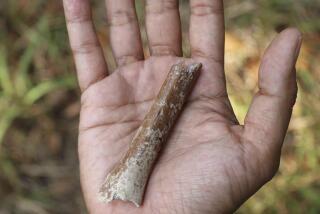Archeological Discovery in Florida : Bones of Prehistoric Man, Animals Found Together
- Share via
MIAMI — The men and women ate well--rabbits, tapir, bison and perhaps a mammoth. They killed with weapons made from limestone and flint. They cooked in a fire pit, remnants of which were buried beside a strangler fig tree in the woods just south of here.
And they lived a long time back--at least 10,000 years ago, far longer than anyone knew man and beast were together in what were then the temperate savannas of South Florida during the last Ice Age.
Tuesday, calling it a major archeological discovery, scientists disclosed these preliminary findings from a three-month-old dig at a remarkably well-preserved site. Their chief excitement was over thousands of fragments of bones, a few of them human, the rest animal.
To find such prehistoric remains of man and beast together is rare. The site promises to tell much about the early humans scientists call Paleo-Indians and about their tools, their health, their diet and their pursuit of prey into the tip of the Florida peninsula, now Dade County.
“Earlier human remains have been found in North America, but only a handful of sites have man in such a clear association with the extinct animals of the Ice Age,” said Robert S. Carr, the county archeologist and head of the dig. “It’s one thing to say they were alive at the same time, but it’s another thing to actually find them together.
“And we’ve found bones from condors, mammoths, bisons--animals never found this far south before. And everything is nicely stratified, one neat layer different from the next.”
The site itself is modest looking, no bigger than a boxing ring, barely deep enough to hold a man standing upright. It sits not far from Old Cutler Road, a major two-lane route into the wealthy neighborhoods south of Miami. It is surrounded by poisonwood, gumbo-limbo and live oaks.
But 100 centuries ago, the scientists speculate, this damp, heavily shaded spot was a limestone cave that offered the lure of shelter.
Burned stone and burned animal remains suggest men there fashioned a broad hearth, big enough for roasting a buffalo.
And deeper into the hole, gnawed bones suggest that this place was once a “carnivore den,” a place where jaguars and dire wolves--monsters of maybe 350 pounds--dragged their kill.
However, none of the evidence has yet been carbon-dated, the process that determines the age of fossils.
The scientific community will eagerly await that testing, which Carr said has already begun.
‘Remarkable Addition’
“If there is a co-occurence, if humans and animals were indeed together in the same age, it would be a remarkable addition,” said George Jefferson, assistant curator of the George C. Page Museum at the La Brea tar pits in Los Angeles.
Human remains at La Brea, for instance, date back 9,000 years, the extinct animals about 11,000 years. There is no overlap, Jefferson said.
Some scientists theorize that man and the prehistoric beasts coexisted about 11,000 years ago. Then, a rapid human invasion led to the animals’ extinction.
“All sites of extinct mammals that have been dated . . . show that animals are gone by 11,000 years ago--10,500 on the outside estimate,” said Paul S. Martin, a proponent of that theory and professor of geosciences at the University of Arizona.
“If the (new) fossil site can show a good 10,000-year-old human occupation, it would require going back to the drawing board.”
Teeth Found on Site
Oddly, it was trespassers who first stumbled upon this archeological bonanza in 1979. While looking for hardwood to fashion into knife handles, they found some animal teeth. They turned them over to Carr, who realized their possible significance immediately.
Much of South Florida is rich terrain for archeologists, though many of the most promising sites are excavated by bulldozers instead. Development has disturbed much of the past irretrievably.
In this instance, the property belongs to heirs of Charles Deering, one of the wealthiest men ever to spend his winters in the warmth of the Florida sunshine.
“The parcel was up for sale, but it’s difficult to say what will happen now,” said J. Deering Danielson, one of those heirs. “I don’t suppose the excavation will take much longer, so we’ll wait and see.”
The artifacts belong to the Deering family, which will donate them to the Florida State Museum in Gainesville and the Historical Conservancy of Miami, Danielson said.
Times researcher Lorna Nones contributed to the reporting of this story.
More to Read
Sign up for Essential California
The most important California stories and recommendations in your inbox every morning.
You may occasionally receive promotional content from the Los Angeles Times.










